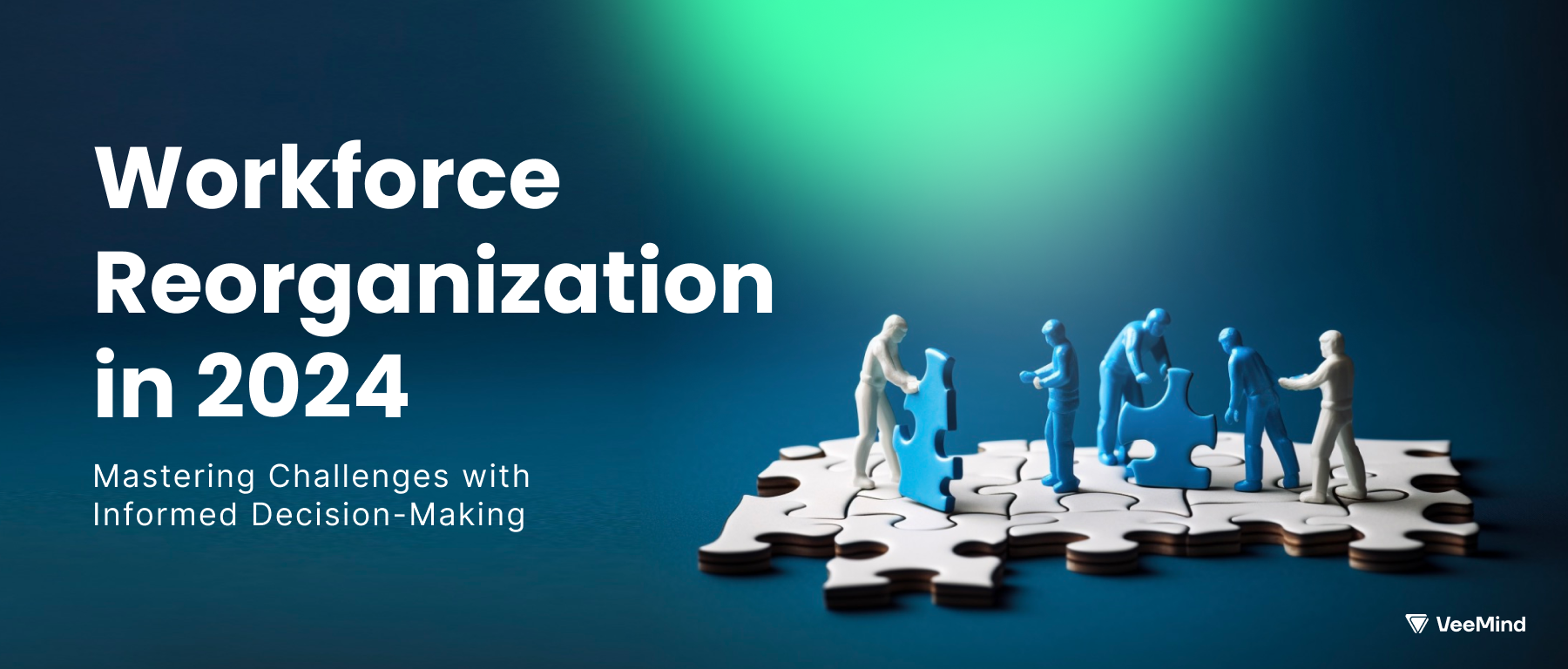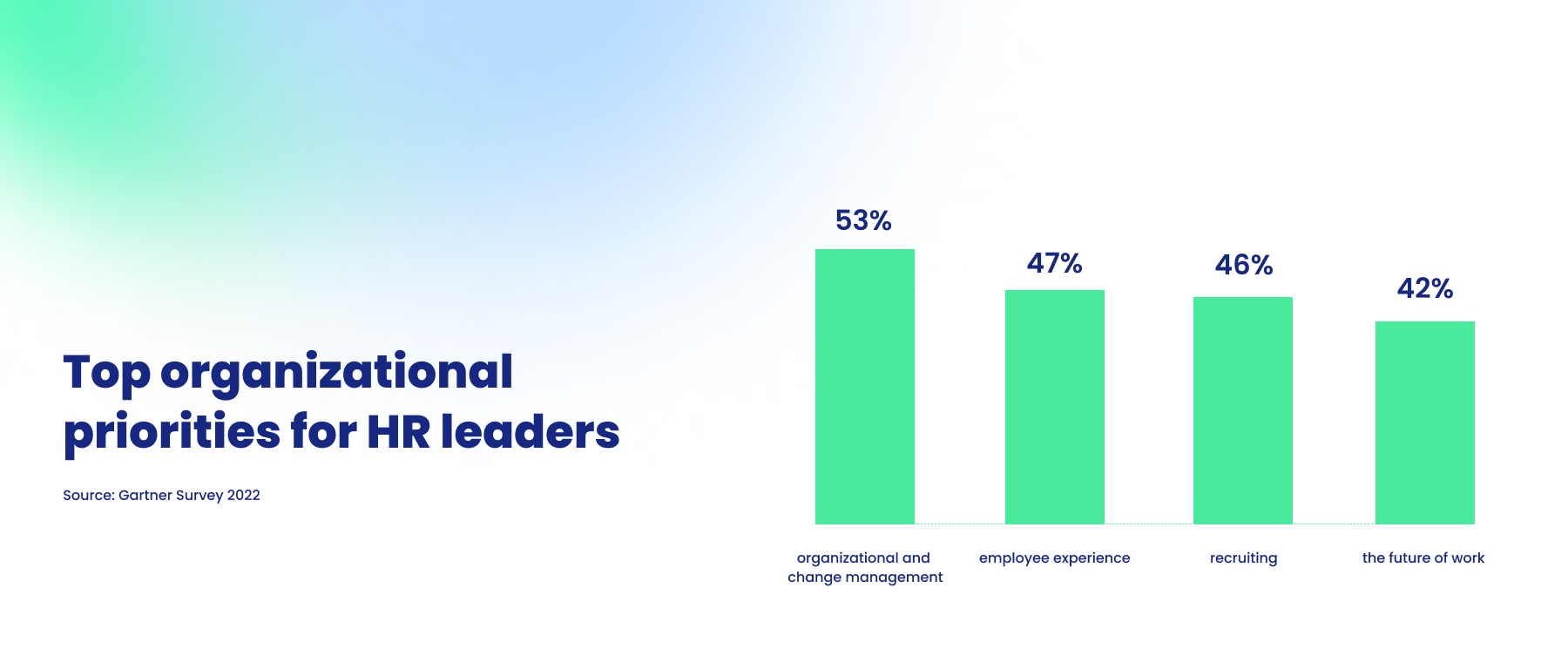Workforce Reorganisation in 2024 - A Challenge For HR

New year, same challenges — economic uncertainty, talent shortages amid the war for skilled professionals, and the imperative to navigate rapid technological disruptions through strategic digital transformation, to name just a few.
These days, businesses face continual challenges and more than ever demanding leaders with a profound understanding of the complications of workforce management. In light of the imperative to optimize cost structures, the critical need for strategic workforce reorganization becomes apparent. In this milieu, the role of informed decision-making stands as a core, crucial for leaders—be they HR Directors, Team Managers, or Business Owners—who bear the responsibility of steering organizations through transformative times.
In this article, we want to show how VeeMind’s HR Solutions can serve as a guiding compass, providing essential insights to illuminate the path through the complexities of workforce reorganization. It’s more than a response to change; it’s an orchestration of success crafted to harmonize with the distinctive melody of each organization’s journey.
Workforce Reorganization With VeeMind - A Proactive Step Forward
Today’s economic challenges for businesses, demanding structural change and especially the imperative to optimize cost structures becomes increasingly pressing. This impetus often propels organizations into the realm of workforce reorganization, a strategic maneuver necessitated by the need for efficiency and resilience in the face of economic uncertainties. The overarching goal is to align the workforce with evolving business needs, ensuring agility and sustainability.
But workforce reorganization shouldn’t be just a reaction to economic pressures; it must be a proactive step toward future-proofing an organization. By redistributing responsibilities and possibly downsizing, businesses aim to enhance operational efficiency, rightsize their teams, and realign leadership to better steer the company through changing tides. It’s a strategic response to the challenges of talent shortages, technological disruptions, and economic uncertainties that define the contemporary business landscape. This adaptive approach positions businesses to not only weather the storm but emerge stronger and more resilient in an ever-evolving market.
To tackle the task of workforce reorganization, HR departments have the need for informed decision-making. It’s a delicate balancing act between the necessity to optimize operational costs and the responsibility to safeguard essential leadership and talent within the organization.
Naturally, three key questions arise to guide decision-makers through this complex terrain:
1. Who can take on different responsibilities?
This question addresses the need to assess the adaptability and versatility of current leaders. It involves identifying individuals with the skill sets and capabilities to seamlessly transition into new roles or take on additional responsibilities. The goal is to ensure that the reshuffling of responsibilities aligns with the strengths and competencies of the leaders involved.
2. Who is a candidate for transition?
Transitioning leaders involves a careful evaluation of their current roles, performance, and potential for growth. This question seeks to pinpoint individuals whose skills and expertise can be strategically reallocated within the organization. It’s about recognizing leaders who, with proper support and development, can contribute effectively in different capacities.
3. Who is an essential leader within the organization?
Amidst the changes, preserving the core leadership that forms the backbone of the organization is paramount. This question addresses the strategic imperative of identifying leaders whose roles are indispensable for the organization’s continued success. It involves safeguarding those individuals whose knowledge, experience, and leadership are critical for maintaining stability and driving key initiatives.
These questions collectively form a crucial framework for decision-makers navigating the complexities of workforce reorganization. They ensure a strategic and thoughtful approach to the reshaping of teams and leadership, balancing the need for adaptability with the imperative of retaining key talent.
The concrete challenge for businesses lies in the intricate and multifaceted process of evaluating workforce reorganization scenarios. This involves conducting interviews, relying on sometimes unreliable data sources, consuming substantial time and resources, and frequently leaving decision-makers grappling to make well-informed choices.

This is precisely where the significance of clear reporting on employee feedback comes into play. By employing tools VeeMind’s Surveys, organizations gain the ability to target surveys to specific individuals, transcending the barriers posed by organizational size. The real-time data generated from these surveys provides leaders with comprehensive insights into attitudes toward change across various departments. Importantly, these insights can be promptly actioned upon, forming the basis for informed and strategic decision-making.
Informed Decision-Making & Comprehensive Feedback Loop
VeeMind presents an innovative solution for informed decision-making and a comprehensive feedback loop, designed to unravel the complexities of workforce reorganization. Our platform enables anonymous feedback from all stakeholders, ensuring a thorough understanding of leadership behavior during the reorganization process. Additionally, VeeMind precisely identifies adaptable leaders and those whose roles may be reconsidered, offering insights to prioritize development actions for the remaining leadership team post-reorganization.
VeeMind’s solution stands out with a set of features, tailored to facilitate workforce optimization, especially during times of reduction and reorganization.
Here’s a closer look at how it can benefit your organization:
Comprehensive Survey Deployment:
Effortlessly distribute surveys, whether for self-assessment or team evaluations, to gain valuable insights into the leadership qualities prevalent across your organization.
Clear Data Visualization:
The data collected isn’t just raw information; it’s transformed into easily understandable graphs and lists. This visual representation provides HR representatives with a quick, comprehensive overview, enabling them to make well-informed decisions.
Insightful Decision Preparation:
VeeMind’s organized data equips HR representatives with the necessary insights for targeted 1-on-1 sessions. This preparation fosters productive discussions and encourages constructive feedback, ensuring a smoother decision-making process.
Real-Time Results Access:
Leadership is about continuous improvement. With VeeMind, leaders gain instant access to their assessment results. This real-time access enables them to identify areas that need enhancement and take immediate action, fostering a culture of constant self-improvement.
Continuous Improvement Resources:
Leaders can tap into a vast database of tips and tricks. This resource serves as a knowledge hub, allowing leaders to refine specific skills and pursue continuous growth based on their personalized assessment results.
Informed decision-making, backed by a comprehensive feedback loop, is the cornerstone of our commitment to empowering organizations in times of change.
In this transformative phase, businesses are not merely restructuring teams; they are sculpting the future of their organizations.
VeeMind’s role in this journey is not just as a solution provider but as a strategic ally, simplifying decision-making and providing a clear path forward. The challenges of evaluating scenarios, managing interviews, and handling unreliable data sources are met with a streamlined process that not only saves time and resources but ensures decisions are grounded in data-driven insights.
The year 2024 isn’t just a chapter in the business chronicle; it’s a narrative of adaptation and innovation. Those who seize the opportunity to optimize their workforce and restructure with clarity and insight are not merely responding to the demands of the present but are architects of a resilient and thriving future.
With VeeMind, businesses don’t just face change; they lead it.

